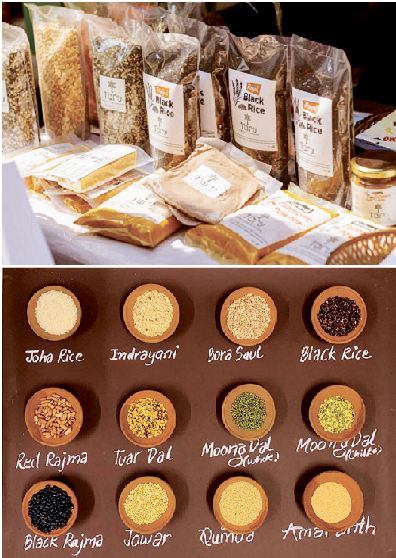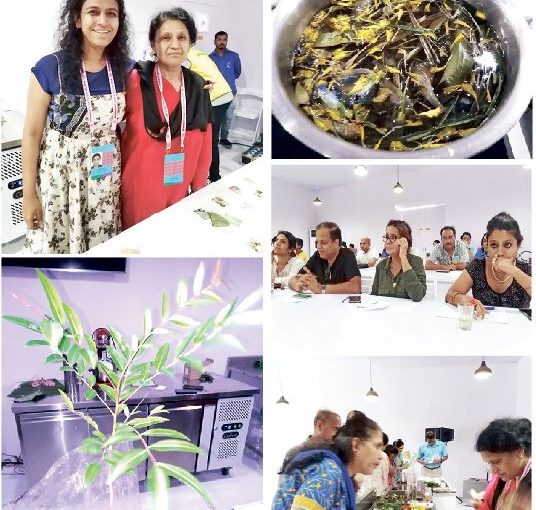Ruchi Jain with Dr Punam Jain in togetherness in promoting healing culinary remedies; a tempting green tea brew of leaves and flowers; those who attended the workshop were curious with questions… of course there was gentle sipping of the hot leafy, flowery teas! Plant picture is that of a taru tree sapling
Note: The Mumbai-based Jains of Taru Naturals support the livelihood of small holder farmers and tribal communities. While Dr Punam is a naturopath doctor innovating new ways of eating, her daughter Ruchi Jain, with her Master’s degree in Environment Change & Management from Oxford University, works at networking and empowering farming communities and building up better food synergies between farmers and markets.
By Tara Narayan
Eating is Fun / Eating is Yuck! – A variety food column
ACTUALLY, there were several interesting and dynamic culinary workshops at the Serendipity Arts Festival last year, that is from December 15 to 22, 2019. It was impossible to attend all of them like I would have liked to but it was not be. I made it for few selected ones though and my favorite takeaway workshop was definitely the one where this talkative Dr Punam Jain and reticent daughter Ruchi Jain duo of Taru Naturals waxed lyrical over dropping a few leaves and/or flowers in a pot of boiling water to brew an agreeably pretty, exquisitely mildly tasting leafy, floral tea… drink up, for it’s good for it’s good for you!
Herbal and floral make for great pick-me-ups morning times and I dare say are superior than regular milk teas or coffees. This is to say it’s my latest calling to put water to boil and drop in a pinch of cumin, coriander or thymol (ajwain) seeds…sometimes aniseed or the more slender, curvaceous greener saunf called badi saunf… boil a bit till water turns into a light or darker golden or green, strain and sip quietly in harmony with whatever Mother Nature you have around you. Nice, very nice.
Similarly, you may put brew the green leaves of tulsi or holy basil, ajwain leaves or lemongrass leaves (be careful how you handle them, their sharp edging can cut fingers) in boiling water, brew and pour out to sip on a cool morning or evening or last thing at night. Combine them with flower petals if you wish – of hibiscus, gauti roses, marigolds, chamomile…they make for teas palely delicate and beautiful looking to heal the blues and a myriad aches and pains!
I’ve always found that dry chamomile flowers make for a very agreeable delicious and sedative tea. Grated ginger makes for a natural painkilling tea…check it out, check it out the next time you have a headache or the migraine. There is healing in leaves, flowers, seeds. And with this let me take you to a very educative healing Culinary Legacies workshop conducted by Dr Punam Jain and daughter Ruchi Jain.
The workshop continued beyond two hours because of the interest it created amongst the audience! It finally ended with all of us being gifted with bundles of various leaves to take home and brew to heal ourselves and our home atmospheres! For the chatty Dr Punam Jain of Taru Naturals wove magic in a host of herbal leaves and flowers which can cheer up life by way of home remedies from the kitchen or garden. To use as first aid medicine make your own bio-enzymes to spray around as air purifiers or to chase away pests, generally speaking all for the cause of reducing our carbon footprint on earth. Tread softly because we tread on our Mother Earth’s dreams for humankind! Something like that and I believe in all that with my mind and body, heart and soul.
I took a real shine to this Dr Punam Jain and find myself totally with her. What did she say and demonstrate at the workshop? In a nutshell, use more flowers, herbs, spices, in more simple ways than cooking them in food for better health parameters. From what Dr Jain said she came to a critical crossroads when she quit her job sometime 2014 and started travelling around India and started a small scale project called Taru Naturals to help farmers grow and market what she calls natural artisanal super foods. She studied herbal plants which she knew can better serve us as preventive healthcare in our homes and even serve us well in first aid emergencies.

FLOWER REMEDIES
Dr Poonam and daughter Ruchi have also been promoting famous German-based therapy of Bach Flower Remedies which rely on a host of flower distillations to promote wellbeing. But she says we have our own flower remedies with medicinal values but these plants are getting lost in the wild, we have our own Indian flower remedies rooted in Ayurveda and the alternate traditional schools of health, “We are losing a 5,000 years old legacy with so much to offer us,” she warned.
The big challenge is to find, preserve and bring back to live the original wild seeds, for all this is also about saving seeds. These are our heirloom seeds, “and they can be safe only in cowdung!” Mrs Punam Jain would like to get chefs involved in the movement to save the original seeds of our natural herbal wealth. They must stop using imported seeds tampered with pesticides which are bad for agriculture, “Agriculture in soil is like our body, rich in microorganisms which give food for entire body.” She draws apt analogies, “Soil is stomach of our planet.” Make the connection between microorganisms, good bacteria, enzymes…all of which go into making and preserving soil nutrition, soil is stomach of our planet, always remember that.
She says part of being Indian is to be part of Ayurveda. Study our herbs of brahmi, shankerpushpi, tulsi, etc, which make for great water distillates and remedies too (like Bach Flower Remedies), “You may get any flower remedy by just filling a glass with three-quarters pure water and adding four or five drops of any flower essence or distillate, like Sri Sri’s Shakti drops…purify any water by using flower or plant distillates. I make my own medicines which work for everybody for such things as coughs….herbs have synergy. Herbals are for wellbeing.”
She has invented Indian flower remedies, “Just float flowers in bowl of water in sun, and drink up!” Drink green teas, she urged, bring mulberry leaves to a boil till you get a pale green tea, drink it. Think of flowers and leaves, think parijat flowers, think mogra flowers, think light pink desi roses which go into the making of fragrant gulkand, yes…think wild marigolds. Also, think leaves, there are 300 varieties of basil in India beginning from Ram tulsi, Krishna tulsi, sabja (falooda seeds) which are like chia seeds; also think nirgundi. Dr Punam Jain reels of names to make one’s head spin! Do you know the betel leave has natural fluoride, “Eat a betel leaf after every meal…we’re eating very unbalanced food nowadays!”
Some more, when did you last look at hibiscus plant, it offers a lot of uses, both leaves and flowers, “Crush leaves and flowers in hot water till soft, soupy froth forms, strain and drink. You can eat a single hibiscus flower daily!” You may get hibiscus syrup (it’s available in Chennai), it is a powerful coolant, hibiscus tea one may get from Auroville…also, eat leafy chutney. Make use of stone mortar and pestle to make chutney and no use of aluminium vessels in kitchen please, use steel or matka, she cooks her rice and dal in matka.
All this and much more by way of valuable and fascinating tips from this amazing mother and daughter team who complemented and tempered each other in sharing their knowledge at the culinary legacies workshop which I so enjoyed. It was lapped up by the audience and naturally I returned home that day with thoughts of living on a diet of leaves and flower petals, etc… to arrive at an emotionally happy state of mind! The story is floral and leafy tea remedies make for super remedies to drain away emotions of anger and frustration, so…er… drink up, but do your homework first, okay.
I rather like the idea of brewing mulberry leaves which they say make the tastiest tea and by the way some of these herbal/floral tea remedies also make for great gargling. My problem now post-workshop is where can I find mulberry leaves in my local marketplace and may I substitute mulberry leaves with hibiscus leaves? The fruit of the mulberry shrub is also a super food but mulberries are hard to find and when you find them once in a way they are not cheap! Must communicate with Dr Punam Jain about all this and ask her some more questions, she reminds me nostalically of my now gone with the wind friend, the late Dr Vijaya Venkat, who too left an unforgettable impression in my diary of life and times or so to speak.
